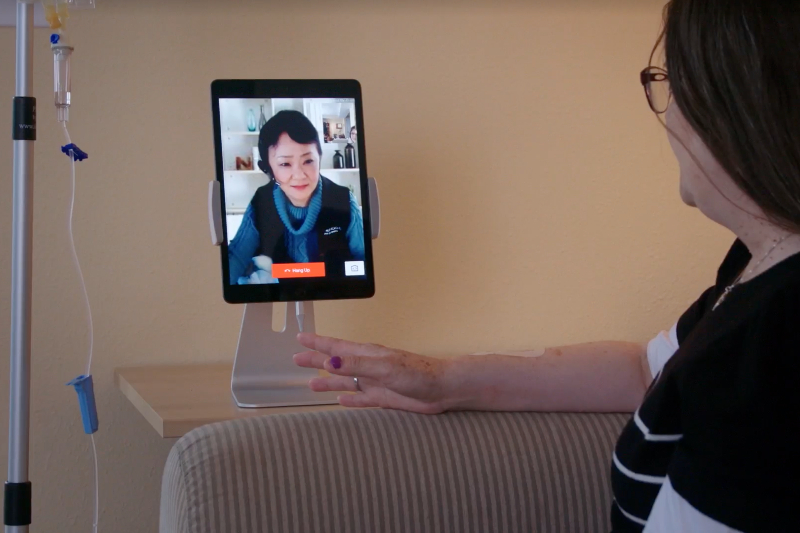Protecting patient health resulting from climate change requires coordinated efforts from physicians, health systems, and communities. Learn how Permanente Medicine is tackling this challenge.

Groundbreaking advanced care at home models allow patients to receive care at home, connected to a medical care team either via at-home visits or video calls on a provided mobile device.
Care at home is the hospital experience of the future

A feeling of disbelief is what I remember most when recalling what a mentor told me decades ago: that hospitals of the future would provide only intensive care and advanced surgical care services. Having seen the recent transformation of health care delivery at the hands of technological advances and performance-based care models, I now realize that she was onto something.
In the next 5 to 10 years, many services currently provided in brick-and-mortar hospitals may well be moved into the home. Physicians and clinicians are already bringing services to patients in new ways, giving them more autonomy and control over their care and health conditions.
At a time when hospital capacity is strained and medical teams are burned out, physicians and patients should embrace the migration to hospital-at-home programs that promote a holistic, patient-centric experience. Given the variety of programs and strategies now in development, it is also important that we and other health care leaders share learnings and best practices with each other.
Pandemic fuels adoption of at-home care
The COVID-19 pandemic substantially increased the adoption of at-home care. One study shows that people with chronic conditions who used telehealth services during the pandemic were more likely to have better health outcomes and less likely to need an emergency room visit or hospitalization. While hospital-like home care was once limited to diagnoses such as heart failure or cellulitis, physicians can now provide home services for conditions such as asthma, pneumonia, chronic obstructive pulmonary disease, cancer, and more. Technological advances allow for reliable and timely access to on-demand laboratory services, mobile radiology, electrocardiograms, and even ultrasound.
Groundbreaking advanced care-at-home models are fueling the shift to more complex in-home services.
By gaining a firsthand view of the contributing social and behavioral health factors that might affect a person’s condition, physicians can gain a better understanding of the root causes of a person’s medical issues. For example, seeing the medications patients have on their kitchen table, how they monitor their condition, whether they eat healthy foods, and the cleanliness and safety of their home can help physicians make more informed recommendations and develop a holistic care plan. In many ways, we are going back to the future, to the era of house calls. But with today’s technology, we can reach more patients than ever.
By inviting physicians into the home instead of visiting a hospital, patients embrace ownership of their care, resulting in reports of greater patient satisfaction. Continuity of care provides a more seamless experience for patients. While the delivery of services provided at brick-and-mortar hospitals can be disjointed following a discharge, at-home care allows the hospital physician to reliably connect with a patient’s primary care physician or specialist to ensure an effective transition of care outside of the acute care setting.
3 challenges to moving forward
To support at-home care programs moving forward, we must keep 3 challenges top of mind:
- At-home care programs need to limit the burden of care placed on patients or caregivers by providing necessary services virtually or physically in the home, including physical therapy, social worker support, and healthy meals.
- At-home care measures need to be developed to adequately determine what quality and timely care looks like to ensure the best outcomes. More advanced remote patient monitoring capabilities and new quality measures, such as response time to a call from a patient (akin to the call button in a hospital), will hold at-home care programs accountable and promote responsive patient-centered care.
- The visibility of at-home care programs must increase so patients, physicians, and staff will know these programs are available and that they provide a viable, safe option. Pre-enrollment programs that identify people with comorbidities or require multiple admissions can educate eligible people and allow them to consult with their primary care physician on how advanced at-home care can improve their health and address their overall care goals.
Groundbreaking advanced care-at-home models are fueling the shift to more complex in-home services. As health care stakeholders, we should embrace this transformation to provide the best experiences for the people we serve every day.
Stephen Parodi, MD, is instrumental in leading acute care-at-home models for Kaiser Permanente. He is an executive vice president at The Permanente Federation, and also serves as an associate executive director for The Permanente Medical Group with responsibility for hospital operations, inpatient quality, patient safety, care of complex and special needs populations, skilled nursing facilities, home health, hospice, and advanced analytics.


